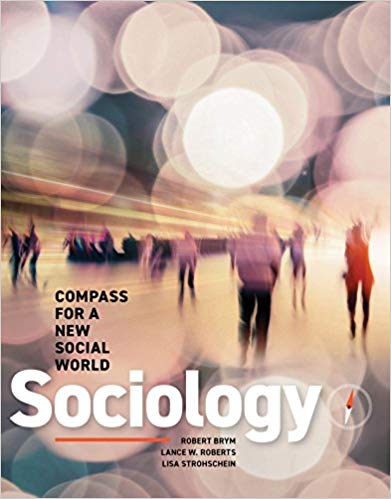This is completed downloadable of Test Bank for Sociology Compass for a New Social World 6th Canadian Edition by Brym

Product Details:
- ISBN-10 : 0176849696
- ISBN-13 : 978-0176849696
- Author:
A compelling design, research focus, and an engaging narrative defines Sociology: Compass for a New Social World. The renowned author team shows students how thinking sociologically can help them draw connections between themselves and the social world. Sociological concepts are clearly connected to students’ interests and experiences by taking universal and popular elements of contemporary culture and rendering them sociologically relevant. This text devotes more space than others do to drawing connections between objectivity and subjectivity in research, presenting a more realistic, and therefore more exciting, account of how sociologists practise their craft. Tables and graphs are not simply referred to, they are analyzed. Some theories are rejected, while others are endorsed. The author team brings depth to issues of diversity and globalization using personal and research experiences.
Table of Content:
- PART 1 Foundations
- CHAPTER 1 A Sociological Compass
- Introduction
- Why You Need a Compass for a New World
- The Goals of This Chapter
- The Sociological Perspective
- The Sociological Explanation of Suicide
- Suicide in Canada Today
- From Personal Troubles to Social Structures
- BOX 1.1 IT’S YOUR CHOICE: SUICIDE AND THE INNU OF LABRADOR
- The Sociological Imagination
- BOX 1.2 SOCIOLOGY AT THE MOVIES: HIDDEN FIGURES
- BOX 1.3 SOCIOLOGY ON TV: SHOCK TV GETS POLITICAL
- Origins of the Sociological Imagination
- Theories, Research, and Values
- Theories
- Research
- Values
- Sociological Theory and Theorists
- Functionalism
- Conflict Theory
- Symbolic Interactionism
- Feminist Theory
- Fashion Cycles and the Four Theoretical Perspectives
- Functionalism
- Conflict Theory
- Symbolic Interactionism
- Feminism
- A Sociological Compass
- Equality vs. Inequality of Opportunity
- Freedom vs. Constraint
- Why Sociology?
- Careers in Sociology
- BOX 1.4 SOCIAL POLICY: WHAT DO YOU THINK?: ARE CORPORATE SCANDALS A PROBLEM OF INDIVIDUAL ETHICS OR SOCIAL POLICY?
- Summary
- Note
- CHAPTER 2 How Sociologists Do Research
- Science and Experience
- OTTFFSSENT
- Levels of Experience
- Scientific vs. Unscientific Thinking
- Research Preliminaries
- Research Approaches
- The Research Act: Connecting Ideas to Evidence
- Ethical Considerations
- BOX 2.1 SOCIAL POLICY: WHAT DO YOU THINK?: GOVERNMENT NUTRITIONAL EXPERIMENTS IN RESIDENTIAL SCHOOLS
- BOX 2.2 SOCIOLOGY AT THE MOVIES: ZERO DARK THIRTY
- Quantitative Approaches
- Measuring Variables
- Experiments
- Surveys
- BOX 2.3 IT’S YOUR CHOICE: PRIVACY, POLITICS, AND THE CANADIAN CENSUS
- Qualitative Approaches
- Participant Observation
- BOX 2.4 SOCIOLOGY ON TV: UNDERCOVER BOSS
- Qualitative Interviewing
- The Importance of Being Subjective
- Summary
- PART 2 Basic Social Processes
- CHAPTER 3 Culture
- Culture as Problem Solving
- Culture as Meaning Generator
- Culture Defined
- The Origins of Culture
- Four Types of Norms: Folkways, Mores, Taboos, and Laws
- BOX 3.1 SOCIOLOGY AT THE MOVIES: SPOTLIGHT
- Culture and Biology
- The Evolution of Human Behaviour
- Language and the Sapir-Whorf Thesis
- A Functionalist Analysis of Culture: Culture and Ethnocentrism
- Culture as Freedom
- Symbolic Interactionism and Cultural Production
- Cultural Diversity
- Multiculturalism
- BOX 3.2 SOCIAL POLICY: WHAT DO YOU THINK?: SHOULD RELIGIOUS SYMBOLS BE BANNED IN PUBLIC SPACES?
- A Conflict Analysis of Culture: The Rights Revolution
- BOX 3.3 IT’S YOUR CHOICE: FEMALE GENITAL MUTILATION: CULTURAL RELATIVISM OR ETHNOCENTRISM?
- From Diversity to Globalization
- Postmodernism
- Canada: The First Postmodern Culture?
- Culture as Constraint
- BOX 3.4 SOCIOLOGY ON TV: THE CROWN
- Rationalization and Time Use
- Consumerism
- From Counterculture to Subculture
- Cultural Capital
- Virtual Culture as Freedom and Constraint
- Summary
- CHAPTER 4 Socialization
- The Consequences of Social Isolation in Childhood
- BOX 4.1 SOCIOLOGY AT THE MOVIES: THE SPACE BETWEEN US
- Formation of the Self
- Freud
- Cooley’s Symbolic Interactionism
- Mead
- At the Intersection of Biography and History
- A Sociology of the Life Course
- Age Cohort
- Generation
- How Socialization Works
- Theories and Agents of Socialization
- Families
- Schools: Functions and Conflicts
- Symbolic Interactionism and the Self-Fulfilling Prophecy
- Peer Groups
- The Mass Media
- BOX 4.2 SOCIAL POLICY: WHAT DO YOU THINK?: CYBER-BULLYING
- The Mass Media and the Feminist Approach to Socialization
- Resocialization and Total Institutions
- Socialization and the Flexible Self
- Self-Identity and the Internet
- BOX 4.3 SOCIOLOGY ON TV: SELF-TRANSFORMATION: EXTREME MAKEOVER AND ITS SPINOFFS
- Summary
- CHAPTER 5 Social Interaction
- The Building Blocks of Interaction
- BOX 5.1 SOCIOLOGY ON TV: SUITS
- BOX 5.2 SOCIOLOGY AT THE MOVIES: WE LIVE IN PUBLIC
- Feminist Theory and Emotions
- Emotion Management
- Emotion Labour
- Emotions in Historical Perspective
- Conflict Theories of Social Interaction
- Competing for Attention
- Power and Social Interaction
- BOX 5.3 SOCIAL POLICY: WHAT DO YOU THINK?: HAVE SOCIAL MEDIA RUINED INTERPERSONAL COMMUNICATION?
- Power and Position
- Symbolic Interaction
- Goffman’s Dramaturgical Analysis
- Ethnomethodology
- Verbal and Nonverbal Communication
- From Small Processes to Big Structures
- BOX 5.4 IT’S YOUR CHOICE: DOES NEGOTIATING SOCIAL ORDER TAKE TOO MUCH TIME AND ENERGY?
- Summary
- CHAPTER 6 Networks, Groups, Bureaucracies, and Societies
- Beyond Individual Motives
- The Holocaust
- How Social Groups Shape Our Actions
- BOX 6.1 SOCIAL POLICY: WHAT DO YOU THINK?: GROUP LOYALTY OR BETRAYAL?
- Social Networks
- It’s a Small World
- Finding a Job
- Urban Networks
- Online Networks
- The Building Blocks of Social Networks
- BOX 6.2 SOCIOLOGY ON TV: WESTWORLD
- Is Group Loyalty Always Functional?
- Love and Group Loyalty
- Primary and Secondary Groups
- Benefits of Group Conformity
- Disadvantages of Group Conformity
- Groupthink and Bystander Apathy
- Group Conformity, Group Conflict, and Group Inequality
- Groups and Social Imagination
- Bureaucracies
- Bureaucratic Inefficiency
- Bureaucracy’s Informal Side
- BOX 6.3 SOCIOLOGY AT THE MOVIES: THE ZOOKEEPER’S WIFE
- Leadership
- Overcoming Bureaucratic Inefficiency
- Societies
- Foraging Societies
- Pastoral and Horticultural Societies
- Agricultural Societies
- Industrial Societies
- Postindustrial Societies
- Postnatural Societies
- Freedom and Constraint in Social Life
- Summary
- PART 3 Inequality
- CHAPTER 7 Deviance and Crime
- The Social Definition of Deviance and Crime
- The Difference between Deviance and Crime
- Sanctions
- BOX 7.1 IT’S YOUR CHOICE: VIOLENCE AND HOCKEY: DEVIANT, CRIMINAL, OR NORMATIVE?
- Measuring Crime
- BOX 7.2 SOCIAL POLICY: WHAT DO YOU THINK?: SHOULD MARIJUANA BE LEGALIZED?
- Criminal Profiles
- Explaining Deviance and Crime
- Symbolic Interactionist Approaches to Deviance and Crime
- Functionalist Explanations
- BOX 7.3 SOCIOLOGY AT THE MOVIES: HELL OR HIGH WATER
- BOX 7.4 SOCIOLOGY ON TV: BETTER CALL SAUL
- Conflict Theories
- Feminist Contributions
- Social Control and Regulation
- Internal and External Social Control
- Trends in Social Control
- The Medicalization of Deviance
- The Prison
- Moral Panic
- Alternative Forms of Punishment
- Summary
- CHAPTER 8 Social Stratification
- Patterns of Social Inequality
- Shipwrecks and Inequality
- Economic Inequality in Canada
- Explanations of Income Inequality
- Income vs. Wealth
- BOX 8.1 SOCIAL POLICY: WHAT DO YOU THINK?: SHOULD WEALTH TRUMP WORK?
- Income and Poverty
- Explaining Poverty
- BOX 8.2 IT’S YOUR CHOICE: SHOULD THE GOVERNMENT PROVIDE A GUARANTEED INCOME?
- Theories of Stratification
- Conflict Perspectives
- Power
- BOX 8.3 SOCIOLOGY AT THE MOVIES: THE HUNGER GAMES
- BOX 8.4 SOCIOLOGY ON TV: TREME: HOW INEQUALITY SHAPES DISASTER
- Social Mobility
- Perceptions of Class Inequality
- Summary
- CHAPTER 9 Globalization, Inequality, and Development
- The Creation of a Global Village
- The Triumphs and Tragedies of Globalization
- The Sources and Contours of Globalization
- Globalization in Everyday Life
- BOX 9.1 SOCIAL POLICY: WHAT DO YOU THINK?: CAN WORK CONDITIONS BE IMPROVED IN CLOTHING FACTORIES IN DEVELOPING COUNTRIES?
- The Sources of Globalization
- BOX 9.2 SOCIOLOGY ON TV: THE AMAZING RACE
- A World Like the United States?
- Globalization and Its Discontents: Anti-Globalization and Anti-Americanism
- The History of Globalization
- Development and Underdevelopment
- Levels and Trends in Global Inequality
- Modernization Theory: A Functionalist Approach
- Dependency Theory: A Conflict Approach
- Core, Periphery, and Semiperiphery
- Neoliberal vs. Democratic Globalization
- Globalization and Neoliberalism
- Foreign Aid, Debt Cancellation, and Tariff Reduction
- BOX 9.3 SOCIOLOGY AT THE MOVIES: CAPTAIN PHILLIPS
- Democratic Globalization
- Summary
- Notes
- CHAPTER 10 Race and Ethnicity
- Defining Race and Ethnicity
- The Great Brain Robbery
- Race, Biology, and Society
- Ethnicity, Culture, and Social Structure
- BOX 10.1 SOCIOLOGY AT THE MOVIES: ZOOTOPIA
- Ethnic and Racial Stratification in Canada
- Canadian Multiculturalism
- BOX 10.2 IT’S YOUR CHOICE: SHOULD WE RECRUIT FEWER IMMIGRANTS AND VISIBLE MINORITIES?
- Race and Ethnic Relations: The Symbolic Interactionist Approach
- Labels and Identity
- Ethnic and Racial Labels: Imposition vs. Choice
- BOX 10.3 SOCIOLOGY ON TV: MASTER OF NONE
- Conflict Theories of Race and Ethnicity
- Internal Colonialism
- BOX 10.4 SOCIAL POLICY: WHAT DO YOU THINK?: IS THE NATIONAL INQUIRY INTO MISSING AND MURDERED INDIGENOUS WOMEN AND GIRLS NEEDED?
- The Theory of the Split Labour Market and the Case of Asian Canadians
- Some Advantages of Ethnicity
- The Future of Race and Ethnicity in Canada
- Summary
- CHAPTER 11 Sexualities and Gender Stratification
- Sex, Intersex, Gender, Transgender
- Sex and Intersex
- Theories of Gender
- Essentialism: Sociobiology and Evolutionary Psychology
- Functionalism and Essentialism
- A Critique of Essentialism from the Conflict and Feminist Perspectives
- Social Constructionism and Symbolic Interactionism
- Gender Segregation and Interaction
- The Mass Media and Body Image
- BOX 11.1 SOCIOLOGY ON TV: TODDLERS & TIARAS
- Male–Female Interaction
- Sexuality
- Sexuality and Resistance
- Enforcing Heteronormativity
- BOX 11.2 SOCIOLOGY AT THE MOVIES: THE IMITATION GAME
- Gender Inequality
- The Origins of Gender Inequality
- The Women’s Movement
- Gender Inequality in the Labour Market
- Eliminating the Gender Gap in Earnings
- Male Aggression against Women
- BOX 11.3 IT’S YOUR CHOICE: DOES A RAPE CULTURE EXIST ON UNIVERSITY AND COLLEGE CAMPUSES?
- Summary
- CHAPTER 12 Sociology of the Body: Disability, Aging, and Death
- Thinking about the Human Body Sociologically
- BOX 12.1 SOCIOLOGY AT THE MOVIES: ROBOCOP
- Society and the Human Body
- The Body and Social Status: A Feminist Interpretation
- Disability
- Disability in Canada
- The Social Construction of Disability
- Rehabilitation and Elimination
- Ableism
- Challenging Ableism: The Normality of Disability
- BOX 12.2 SOCIOLOGY ON TV: FROM MALCOLM IN THE MIDDLE TO SPEECHLESS
- Aging
- The Sociology of Aging
- Population Aging in Canada and Around the World
- Intergenerational Tensions: A Conflict Interpretation
- Death and Dying
- BOX 12.3 IT’S YOUR CHOICE: NEGOTIATING THE AMBIGUITY BETWEEN SOCIAL AND BIOLOGICAL DEATH
- BOX 12.4 SOCIAL POLICY: WHAT DO YOU THINK?: PHYSICIAN-ASSISTED DEATH: NOT FOR THOSE WITH A MENTAL ILLNESS
- Summary
- PART 4 Institutions
- CHAPTER 13 Work and the Economy
- The Promise and History of Work
- Salvation or Curse?
- Economic Sectors and Revolutions
- “Good” vs. “Bad” Jobs
- The Deskilling Thesis
- BOX 13.1 SOCIAL POLICY: WHAT DO YOU THINK?: ARE YOU PREPARED FOR DIGITAL TAYLORISM?
- A Critique of the Deskilling Thesis
- The Social Relations of Work
- Labour Market Segmentation
- Worker Resistance and Management Response
- BOX 13.2 IT’S YOUR CHOICE: SUPPORTING A REDUCED WORKWEEK
- Unions and Professional Organizations
- Barriers between the Primary and Secondary Labour Markets
- The Time Crunch and Its Effects
- The Problem of Markets
- Capitalism, Communism, and Democratic Socialism
- Capitalism
- BOX 13.3 SOCIOLOGY ON TV: DRAGONS’ DEN
- Communism
- BOX 13.4 SOCIOLOGY AT THE MOVIES: THE BIG SHORT
- Democratic Socialism
- The Corporation
- Globalization
- Globalization in the Less Developed Countries
- The Future of Work and the Economy
- Summary
- CHAPTER 14 Politics
- Introduction
- Free Trade and Democracy
- What Is Politics? Key Terms
- BOX 14.1 SOCIOLOGY ON TV: GAME OF THRONES
- Theories of Democracy
- A Functionalist Account: Pluralist Theory
- Conflict Approaches I: Elite Theory
- BOX 14.2 IT’S YOUR CHOICE: INCREASING THE PARTICIPATION OF WOMEN IN CANADIAN POLITICS
- BOX 14.3 SOCIOLOGY AT THE MOVIES: THE IDES OF MARCH
- Conflict Approaches II: Marxist Rejoinders to Elite Theory
- Conflict Approaches III: Power Resource Theory
- Conflict Approaches IV: State-Centred Theory
- The Future of Democracy
- Two Cheers for Russian Democracy
- The Three Waves of Democracy
- The Social Preconditions of Democracy
- Postmaterialism and the Dilemma of Canadian Politics
- Politics by Other Means
- War
- Terrorism and Related Forms of Political Violence
- Summary
- Notes
- CHAPTER 15 Families
- Is “The Family” in Decline?
- Functionalism and the Nuclear Ideal
- Functional Theory
- Foraging Societies
- The Canadian Family in the 1950s
- Conflict and Feminist Theories
- The Gender Division of Labour
- Mate Selection
- Love and Mate Selection
- BOX 15.1 SOCIOLOGY AT THE MOVIES: BEAUTY AND THE BEAST
- Marriage and Cohabitation
- Living Apart Together
- Same-Sex Marriage and Civil Unions
- BOX 15.2 SOCIOLOGY ON TV: THE REAL O’NEALS
- Divorce
- Predictors of Divorce
- Consequences of Divorce
- Economic Hardship
- Reproduction
- Reproductive Choice
- BOX 15.3 SOCIAL POLICY: WHAT DO YOU THINK?: MEDICAL ABORTION: A NEW OPTION FOR CANADIAN WOMEN
- Reproductive Technologies
- Zero-Child Families
- Lone-Parent Families
- Step-Parent Families
- Family Policy
- Summary
- CHAPTER 16 Religion
- Religion and Society
- Theoretical Approaches to the Sociology of Religion
- Durkheim’s Functionalist Approach
- BOX 16.1 SOCIOLOGY ON TV: FROM DUCK DYNASTY TO THE YOUNG POPE
- Religion, Feminist Theory, and Conflict Theory
- Weber and the Problem of Social Change: A Symbolic Interactionist Interpretation
- The Rise, Decline, and Partial Revival of Religion
- The Rise of Religion
- The End of Religion?
- BOX 16.2 IT’S YOUR CHOICE: PRAYER IN CITY COUNCIL MEETINGS
- The Market Theory
- The Future of Religion
- Religion around the World
- Religious Tolerance
- Religious Affiliation in Canada
- BOX 16.3 SOCIOLOGY AT THE MOVIES: SILENCE
- Religiosity
- Summary
- CHAPTER 17 Education
- The Riot in St. Léonard
- Mass Education: An Overview
- Uniform Socialization
- Rising Levels of Education
- BOX 17.1 SOCIAL POLICY: WHAT DO YOU THINK?: IS GRADE INFLATION HARMFUL?
- Individual Advantages and Disadvantages
- The Rise of Mass Schooling
- Mass Schooling and National Wealth
- BOX 17.2 SOCIAL POLICY: WHAT DO YOU THINK?: IS VIRTUAL LEARNING A GOOD IDEA?
- The Functions of Education
- Latent Functions
- Manifest Functions: The Logic of Industrialism
- Cultural Homogeneity and Solidarity
- Common School Standards
- National Solidarity
- Sorting into Classes and Hierarchies: A Conflict Perspective
- BOX 17.3 SOCIOLOGY ON TV: MR. D
- Economic Barriers to Higher Education
- BOX 17.4 SOCIOLOGY AT THE MOVIES: THE LOTTERY
- Exclusion, Credentialism, and Professionalization
- Cultural Capital and Control
- Reproducing Inequality: The Contribution of Symbolic Interactionism
- The Hidden Curriculum
- Testing and Tracking
- Self-Fulfilling Prophecies
- BOX 17.5 IT’S YOUR CHOICE: IS SCHOOL ENOUGH?
- Prospects and Challenges for Education in Canada
- Gender Differences: A Feminist Perspective
- Participation and Indigenous Background
- International Competition
- Summary
- CHAPTER 18 Mass Media and Mass Communication
- The Significance of the Mass Media
- Illusion Becomes Reality
- What Are the Mass Media?
- BOX 18.1 SOCIOLOGY ON TV: YOU THE JURY
- The Rise of the Mass Media
- Causes of Media Growth
- Theories of Media Effects
- Functionalism
- Conflict Theory
- BOX 18.2 SOCIAL POLICY: WHAT DO YOU THINK?: CANADIAN BROADCASTING AND GOVERNMENT REGULATION
- Interpretive Approaches
- BOX 18.3 SOCIOLOGY AT THE MOVIES: SNOWDEN
- Feminist Approaches
- Centralized Control and Resistance on the Internet
- Access
- Content
- Internet Advertising
- Biased Algorithms
- Online Piracy vs. Net Neutrality
- Countertrends: The Rise of Social Media
- Summary
- CHAPTER 19 Health and Medicine
- The Black Death
- Health and Inequality
- Defining and Measuring Health
- The Social Causes of Illness and Death
- BOX 19.1 SOCIOLOGY AT THE MOVIES: INSIDE OUT
- Health Care and Medicine
- The Canadian Health-Care System: A Conflict Approach
- BOX 19.2 SOCIAL POLICY: WHAT DO YOU THINK?: A MENTAL HEALTH CRISIS ON CANADIAN CAMPUSES
- The Power of Medicine
- The Social Limits of Modern Medicine
- BOX 19.3 SOCIOLOGY ON TV: THE BIG BANG THEORY
- Challenges to Traditional Medical Science
- BOX 19.4 IT’S YOUR CHOICE: DO PARENTS HAVE A DUTY TO VACCINATE THEIR CHILDREN?
- Summary
- PART 5 Social Change
- CHAPTER 20 Population and Urbanization
- Population
- The City of God
- The Population “Explosion”
- BOX 20.1 SOCIOLOGY AT THE MOVIES: INFERNO
- The Malthusian Trap
- A Critique of Malthus
- Demographic Transition Theory
- Population and Social Inequality
- BOX 20.2 SOCIAL POLICY: WHAT DO YOU THINK: HOW CAN WE FIND 120 MILLION MISSING WOMEN?
- Urbanization
- From the Preindustrial to the Industrial City
- The Chicago School and the Industrial City
- After Chicago: A Critique
- The Corporate City
- Rural Communities
- The Postmodern City
- BOX 20.3 SOCIOLOGY ON TV: GIRLS
- Summary
- CHAPTER 21 Collective Action and Social Movements
- How to Spark a Riot
- The Study of Collective Action and Social Movements
- Non-Routine Collective Action
- The Vancouver Riot of 1907
- Breakdown Theory: A Functionalist Approach to Collective Action
- Assessing Breakdown Theory
- Social Movements
- Solidarity Theory: A Conflict Approach
- BOX 21.1 SOCIAL POLICY: WHAT DO YOU THINK?: STATE SURVEILLANCE OF DEMONSTRATIONS
- Strikes and the Union Movement in Canada
- Resource Mobilization
- Political Opportunities
- Social Control
- Framing Discontent: A Symbolic Interactionist Approach
- Examples of Frame Alignment
- An Application of Frame Alignment Theory: Back to 1968
- The History and Future of Social Movements
- The Past 300 Years
- New Social Movements
- BOX 21.2 SOCIOLOGY AT THE MOVIES: V FOR VENDETTA
- BOX 21.3 SOCIOLOGY ON TV: MR. ROBOT
- Summary
- Note
- ONLINE CHAPTER 22 Technology and the Global Environment
- Technology: Saviour or Frankenstein?
- BOX 22.1 SOCIOLOGY ON TV: BATTLESTAR GALACTICA
- Technology and People Make History
- How High Tech Became Big Tech
- Environmental Degradation
- BOX 22.2 SOCIOLOGY AT THE MOVIES: WAR FOR THE PLANET OF THE APES
- The Social Construction of Environmental Problems: A Symbolic Interactionist View
- The Social Distribution of Environmental Risk
- BOX 22.3 IT’S YOUR CHOICE: THE CANADIAN OIL PIPELINE DEBATE
- What Is to Be Done? Functionalist vs. Conflict Solutions
- The Market and High Technology
- A Workable Strategy?
- Evolution and Sociology
- Summary
- Notes
- Refrences
- Index





